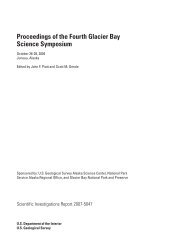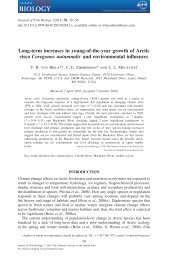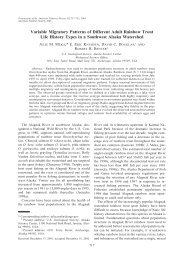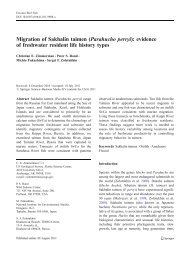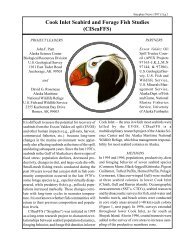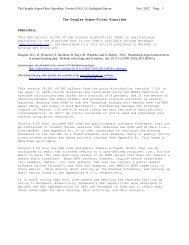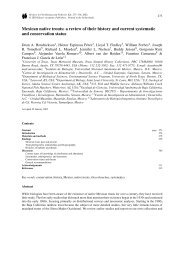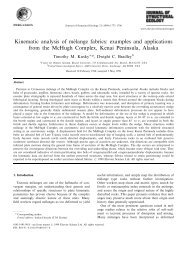Kline, T. C., C. A. Woody, M. A. Bishop, S. P. Powers, and E. E. ...
Kline, T. C., C. A. Woody, M. A. Bishop, S. P. Powers, and E. E. ...
Kline, T. C., C. A. Woody, M. A. Bishop, S. P. Powers, and E. E. ...
You also want an ePaper? Increase the reach of your titles
YUMPU automatically turns print PDFs into web optimized ePapers that Google loves.
ASSESSMENT OF MARINE-DERIVED NUTRIENTS IN THE COPPER RIVER DELTA<br />
lished near the deepest part of the lake. The<br />
“swamp” site located between Lost Point <strong>and</strong><br />
the lake outlet is where the forest is inundated<br />
by the lake <strong>and</strong> where the water appears<br />
stained with dissolved organic material. The<br />
site on Salmon Creek, also a tributary of<br />
McKinley Lake, was near mile marker 21 on<br />
the Copper River Highway (the roadway<br />
crossing the CRD east–west).<br />
The uppermost site (elevation = 10 m<br />
above sea level) on Power Creek was that of<br />
the ab<strong>and</strong>oned USGS gauging station. A clear<br />
side-channel of Power Creek was selected as a<br />
high spawner density site (~1000 spawners<br />
combining all species). Another site was at the<br />
mouth of Power Creek where it enters Eyak<br />
Lake. One Eyak Lake shore site was in Power<br />
Creek Arm (into which Power Creek drains<br />
directly, Davis Cove Turnaround) while the<br />
other was on the South shore near Mavis<br />
Isl<strong>and</strong> in the main body of the lake. The Eyak<br />
River site was located about 500 m downstream<br />
of where Eyak Lake flows into the<br />
Eyak River, which drains to the sea. Beach<br />
spawning takes place in Eyak Lake.<br />
Certain sites were designated coho-only<br />
sites (coho type in Table 1). Coho salmon<br />
spawn farther upstream in Power Creek than<br />
sockeye <strong>and</strong> Salmon Creek is nearly free of<br />
sockeye (only a single stray sockeye has been<br />
observed there recently), thus the upstream<br />
portion of Power Creek <strong>and</strong> Salmon Creek<br />
were designated as coho-only sites.<br />
On the CRD’s intertidal mudflats, sites<br />
were established at high-, mid-, <strong>and</strong> lowintertidal<br />
(respectively, + 2.3–2.4 m, + 1.8 m,<br />
<strong>and</strong> + 1.1–1.4 m relative to the mean lowerlow<br />
water tidal datum) (Table 1). Intertidal<br />
deployment <strong>and</strong> recovery was by helicopter.<br />
Sampling<br />
Wildco Periphyton Samplers (WPS) enabled<br />
controlled incubation of periphyton (also<br />
known as aufwuchs, essentially the organisms<br />
colonizing hard surfaces consisting primarily<br />
of algae) used to establish end-members, an<br />
integral part of SIA methodology (see <strong>Kline</strong> et<br />
al. 1990). A single WPS unit consisted of a<br />
rack with components made plastic <strong>and</strong> stainless<br />
steel holding st<strong>and</strong>ard microscope slides.<br />
Algae, which grow on the slides, are easily<br />
scraped off for analysis. Wildco Periphyton<br />
Samplers were individually numbered <strong>and</strong><br />
incubated at the aforementioned sites (Table 1)<br />
in the Eyak <strong>and</strong> McKinley-Alaganik watersheds<br />
of the CRD during the late summer of<br />
2004, when spawning <strong>and</strong> decomposing sockeye<br />
salmon were present in the system. After<br />
recovery of the WPS, algae were scraped off the<br />
slides <strong>and</strong> freeze-dried. Returning adult <strong>and</strong><br />
outmigrating juvenile sockeye <strong>and</strong> coho salmon<br />
were sampled throughout the summer by<br />
a variety of means (nets, traps, <strong>and</strong> hook <strong>and</strong><br />
line) in both watersheds, freeze-dried, <strong>and</strong><br />
ground to a fine powder. Adult salmon were<br />
also obtained in 2003. The following adult<br />
salmon analyses have been performed: for<br />
2003: N (female coho) = 29, N (male coho) =<br />
23, N (female sockeye) = 17, N (male sockeye)<br />
= 42; for 2004: N (female coho) = 37, N (male<br />
coho) = 21, N (female sockeye) = 14, N (male<br />
sockeye) = 47. Adult samples consisted of<br />
anterior epaxial white muscle tissue whereas<br />
juveniles consisted of the whole fish.<br />
Stable Isotope Analysis<br />
SIA was performed on the dried samples at the<br />
Colorado Plateau Stable Isotope Laboratory.<br />
SIA results are reported in conventional delta<br />
units relative to international isotope st<strong>and</strong>ards,<br />
which are air N 2 for N, Vienna Peedee<br />
Belemnite (VPDB) for C, <strong>and</strong> Canyon Diablo<br />
Triolite for S, expressed respectively as δ15N,<br />
δ13C, <strong>and</strong> δ34S values in terms of 0 / 00 deviations<br />
from these st<strong>and</strong>ards. δ13C values of fishes<br />
were normalized for lipid isotope effects by the<br />
method of McConnaughey <strong>and</strong> McRoy (1979)<br />
<strong>and</strong> denoted by δ13C’. MDN was calculated<br />
from δ15N values using the isotope mixing<br />
model of <strong>Kline</strong> et al. (1993) using an empirical-<br />
55




